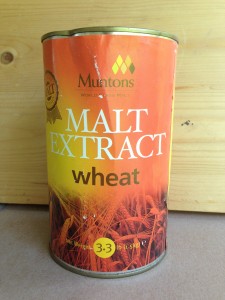This is the first of two articles on extract wort production in the series of articles on barleywine.
When making a barleywine wort from malt extract, there are several things the brewer should consider. All the usual advice still applies — use fresh malt extract, boil as much volume as you can (and still maintain a vigorous boil) and add some of the malt extract late in the boil (if you are boiling less than the full wort).
In addition, some aspects of wort production are only going to apply to barleywine or other big, hoppy beers. One thing that always improves an extract beer is supplementing the extract wort with wort a partial mash. Adding some base malt to your extract recipe adds back some of the malt aroma that was lost when the malt extract was concentrated or dried. This is true for a barleywine as well, but I would recommend making a small partial mash — around 2.0–4.0 lbs. (0.91–1.8 kg) — rather than a larger one. For one thing, although some malt aroma is lost in the manufacture of malt extract, some of it is retained. In a barleywine wort, the large amount of malt extract required means that some malt aroma will be present. More importantly, in an extract barleywine, reducing the amount of trub and hop debris should be a priority. This is especially true when the brewer is boiling less than a full wort.
Partial Mash and Trub Volume
When all-grain wort is boiled, proteins and tannins coagulate and fall to the bottom of the kettle when the boil is shut down. This hot break, along with the cold break that forms when the wort is cooled, should be mostly left behind in the kettle when the wort is transferred to the fermenter. Unfortunately, whatever wort is trapped in the trub is also lost.
Malt extract is made from wort that has already been boiled. In brewery grade malt extract, the hot break should already be (at least mostly) removed. Some manufacturers also separate the cold break. In a barleywine wort, you expect to have a fairly large volume of trub and hop debris. And, the wort lost to the trub will be at a very high density. Keeping your partial mash on the small side (and therefore making most of your wort by dissolving malt extract) will give your beer the boost in malt aroma, without greatly increasing the volume of trub.
Wort Fermentability

Middle of the road fermentability and later middle of the road attenuation will yield a barleywine that finishes in the “20s” (FG 1.020–1.029), giving this big, sipping a beer a proper amount of body and sweetness.
Supplementing your extract barleywine wort by making a partial mash has another benefit — the enzymes from the mash can increase the fermentability of the extract wort. Barleywines are not dry beers, so brewers should not make an effort to make a highly fermentable wort. On the other hand, given the amount of malt used to brew a barleywine, the final gravity is going to be quite high even if the wort is moderately fermentable and the yeast achieve a moderate level of attenuation. So, although you don’t want to strive for a highly fermentable wort, you don’t want to try to make a wort with a low level of fermentability, either. The middle of the road is fine here.
Extract worts tend to be less fermentable than all-grain worts. For lower-gravity barleywines, especially of the English type, this is not a problem. For higher-gravity barleywines — and especially of the American type, which are sometimes slightly more attenuated — increasing the fermentability of your wort somewhat can be a benefit. To do this, once you have run off the wort from the partial mash, stir some of the malt extract into it. If you hold the mix of all-grain wort and malt extract somewhere in the range of 140–162 °F (60–72 °C), the enzymes from the malt will go to work on any modifiable carbohydrates from the extract. If you were making a dry beer, holding the mixture in the lower half of the above range would be a good idea. For a barleywine, holding the mix for about 15 minutes at 152–162 °F (67–72 °C) would work best. Obviously, don’t heat the partial mash wort, unless it drops below 140 °F (60 °C), while collecting it.
For the highest gravity American barleywines made from malt extract, a small amount of (100% fermentable) cane sugar may be needed to keep from producing an overly sweet beer. At most, cane sugar should only amount to 10% of the fermentables.
I will finish discussing extract wort production tomorrow and move onto all-grain wort production — and its influence on recipe decisions — later in the week.
—
Related articles
Five Tips for Extract Brewers


You might want to review your stock photos, the fresh malt extract caption shows a dented and abused can!
Most of our photos are just shots James or I took. I needed a malt extract pic and that beat up can was the only thing I had to shoot.